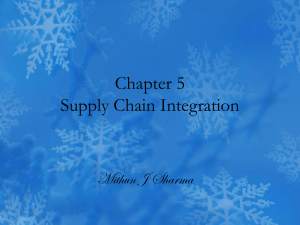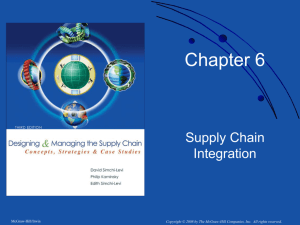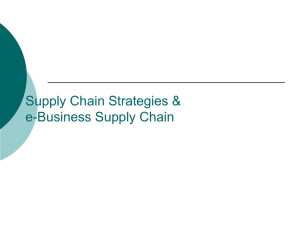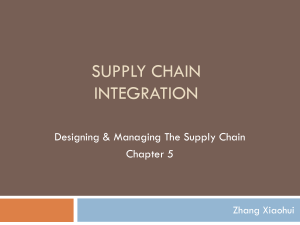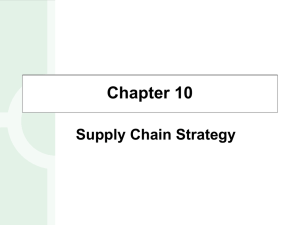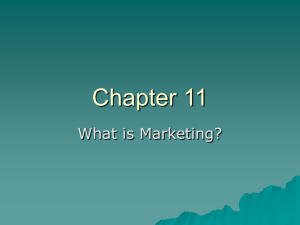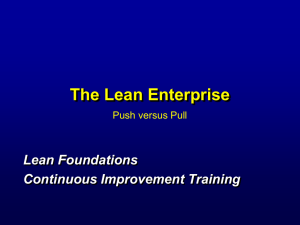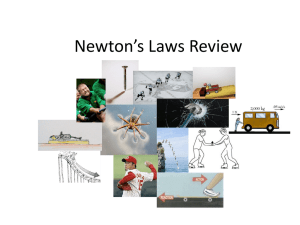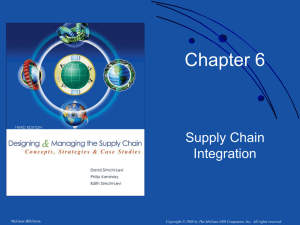Production and Operations Management: Manufacturing and Services
advertisement
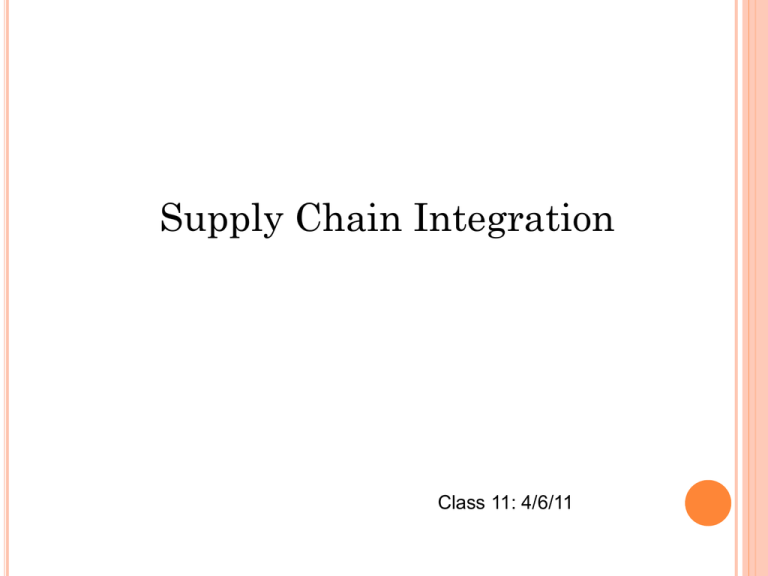
Supply Chain Integration Class 11: 4/6/11 INTRODUCTION Effective SCM implies: Efficient integration of suppliers, manufacturers, warehouses, and stores. Coordinate activities across the supply chain Improve performance: reduce cost, increase service level, reduce the bullwhip effect, better utilize resources, and effectively respond to changes in the market place. Challenges can be met by integrating: the front-end, customer demand, to the back-end, production and manufacturing portion of the supply chain. Various supply chain integration strategies: Push, pull, push–pull strategy. Matching products and industries with supply chain strategies. Demand-driven supply chain strategies PUSH, PULL, PUSH-PULL SYSTEMS Push and Pull traditional categories of manufacturing operations More recent hybrid strategy of combining the two, Push-Pull systems PUSH-BASED SUPPLY CHAINS Production and distribution decisions based on long-term forecasts. Manufacturer demand forecasts based on orders received from the retailer’s warehouses. Longer reaction time to changing marketplace: Inability to meet changing demand patterns. Obsolescence of supply chain inventory as demand for certain products disappears. Variability of orders received much larger than the variability in customer demand due to the bullwhip effect. Excessive inventories due to the need for large safety stocks Larger and more variable production batches Unacceptable service levels Product obsolescence BULLWHIP EFFECT IN PUSH-BASED SUPPLY CHAINS Leads to inefficient resource utilization Planning and managing are much more difficult. Not clear how a manufacturer should determine production capacity? Transportation capacity? Peak demand? Average demand? Results: Higher transportation costs Higher inventory levels and/or higher manufacturing costs more emergency production changeovers PULL-BASED SUPPLY CHAINS Production and distribution demand driven Coordinated with true customer demand rather than forecast demand firm does not hold any inventory and only responds to specific orders. Intuitively attractive: Reduced lead times through the ability to better anticipate incoming orders from the retailers. Reduced inventory since inventory levels increase with lead times Less variability in the system Decreased inventory at the manufacturer due to the reduction in variability. IMPLEMENTATION OF PULL-BASED SYSTEMS Often when lead times are long difficult to implement impractical to react to demand information. more difficult to take advantage of economies of scale Advantages and disadvantages of push and pull supply chains: new supply chain strategy that takes the best of both. Push–pull supply chain strategy PUSH-PULL STRATEGY Some stages of the supply chain operated in a pushbased manner typically the initial stages Remaining stages employ a pull-based strategy. Interface between the push-based stages and the pullbased stages is the push–pull boundary. SUPPLY CHAIN TIMELINE Push-pull supply chains GENERAL STRATEGY Make a part of the product to stock – generic product The point where differentiation has to be introduced is the push-pull boundary Based on extent of customization, the position of the boundary on the timeline is decided IDENTIFYING THE APPROPRIATE SUPPLY CHAIN STRATEGY Push-pull supply chains IMPACT OF DEMAND UNCERTAINTY AND ECONOMIES OF SCALE Demand Uncertainty: Higher demand uncertainty leads to a preference for pull strategy. Lower demand uncertainty leads to an interest in managing the supply chain based on a long-term forecast: push strategy. Economies of scale: The higher the importance of economies of scale in reducing cost The greater the value of aggregating demand The greater the importance of managing the supply chain based on long-term forecast, a push-based strategy. Economies of scale are not important Aggregation does not reduce cost A pull-based strategy makes more sense. IMPLEMENTING A PUSH–PULL STRATEGY Achieving the appropriate design depends on many factors: product complexity manufacturing lead times supplier–manufacturer relationships. Many ways to implement a push–pull strategy location of the push–pull boundary. Dell locates the boundary at the assembly point Furniture manufacturers locate the boundary at the production point IMPACT OF THE PUSH-PULL STRATEGY Push portion Low uncertainty Service level not an issue Focus on cost minimization. Long lead times Complex supply chain structures Cost minimization achieved by: better utilizing resources such as production and distribution capacities minimizing inventory, transportation, and production costs. Supply Chain Planning processes are applied. IMPACT OF THE PUSH-PULL STRATEGY Pull portion High uncertainty Simple supply chain structure Short cycle time Focus on service level. Achieved by deploying a flexible and responsive supply chain Order-fulfillment processes are applied CHARACTERISTICS OF THE PUSH AND PULL PORTIONS OF THE SUPPLY CHAIN Portion Push Pull Objective Minimize cost Maximize service level Complexity High Low Focus Resource allocation Responsiveness Lead time Long Short Processes Supply chain planning Order fulfillment INTERACTIONS OF THE TWO PORTIONS Only at the push-pull boundary Typically through buffer inventory Different role for the inventory in each portion In the push portion, buffer inventory is part of the output generated by the tactical planning process In the pull system, it represents the input to the fulfillment process. Interface is forecast demand Forecast based on historical data obtained from the pull portion Used to drive the supply chain planning process and determine the buffer inventory. THE IMPACT OF LEAD TIME Longer the lead time, more important it is to implement a push based strategy. Typically difficult to implement a pull strategy when lead times are so long that it is hard to react to demand information. IMPACT OF LEAD TIME Matching supply chain strategies with products: the impact of lead time and demand uncertainty IMPACT OF LEAD TIME Box A Box B Items with short lead time and high demand uncertainty Pull strategy should be applied as much as possible. Items with long supply lead time and low demand uncertainty. Appropriate supply chain strategy is push. Box C items with short supply lead time and highly predictable demand. Continuous replenishment strategy Suppliers receive POS data They use these data to prepare shipments at previously agreedupon intervals A pull strategy at the production and distribution stages and push at the retail outlets. Box D Items with long lead times are long and unpredictable demand Inventory is critical in this type of environment Requires positioning inventory strategically in the supply chain SUMMARY Implementation of push-pull strategies and demand-driven strategies have helped many companies to improve performance, reduce costs, increase service levels. Companies need to: Identify the appropriate supply chain strategy for individual products. Case for no physical infrastructure or inventory is tenuous Push–pull strategy advocates holding inventory although it pushes the inventory upstream in the supply chain.

